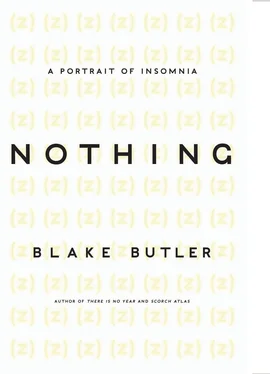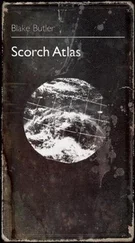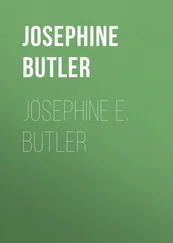Those who could not sleep soundly, we thought for so long, must be otherwise diseased, held of an error in the body, akin to coma, stupor, looming toward death.
Fourth leg in the continuum of deep-seated human physical instincts, and perhaps even more so than what one might call the other three — eating, shitting, fucking — sleep seems the one room always overhead, of its own will. Sleep is the start and end of any set of hours, bookends on voluntary motion, the eyes through it most always closed, set instead to the flashing, patterned panel waiting always underneath the lids. To be dormant, quiescent, or inactive, as faculties. To be careless or unalert. 108
The Old Testament frames sleep as a metaphysical commodity, located only through the grace of god: “In vain you rise early and stay up late, toiling for food to eat — for he grants sleep to those he loves” (Psalm 127:2). Once granted, though, it is a state not to be dwelt in, or overused — there must remain an attentiveness to life’s toil: “Do not love sleep or you will grow poor; stay awake and you will have food to spare” (Proverbs 20:13).
In sickness, as in sleeping, the body wants the bed. As early as the Neolithic Age (~9500 BC), the first mattresses are made of grass and leaves wrapped in skinned hides. Later, in Persia, beds are goatskins filled with water; in Egypt, palm boughs piled into the home; in 200 BC the rich come to prefer feathers, plush linings stolen from living fowl: the dress of bodies borne for flight. Other early beds are bags stuffed with wool or straw or reeds or hay or down. It’s not until the mid-eighteenth century that anything resembling the flat, stitched, and bordered fiber boxes most common at the turn of the twenty-first century appear.
Regardless of what the beds are made of, there are those whose bodies shake upon them, stricken waking, open to the night. Many go uncounted. Days then contain the same duration as days now.
In early Egypt, for those stricken sleepless, there is bloodletting, dream interpretation, enema, opium, magic, prayer to angry gods.
In India and China, there are vegetables and herbs.
In Greece: attention to architecture, water, light, and nature; balance of body fluids; medicines from snakes and geese.
The Greek god of sleep is Hypnos, son of Nix, the god of night; brother of Thanatos, the god of death; husband to Pasithea, the goddess of hallucination. When Hypnos and his wife touch, godflesh to godflesh, it was written, “from slumber woke all nations of the earth.”109
In Rome, the god of sleep is Somnus, said to have one thousand sons, many of whom could assume different forms.
Likewise, the houses, as the beds have, continue to evolve. Architecture teaches these rooms more solid ways to keep the outside out and inside in. Roofs are slanted to let rain roll off and soften earth for farming. Pipes carry heat and water from other buildings beneath the house, into the house, lacing the walls. The bodies within the morphing surfaces carry on.
Around 400 BC, Hippocrates first specifies the state of dreaming as a medical condition. “Sleep is due to blood going from the limbs to the inner regions of the body,” he suggests, characterizing the resting body as a volume drawing inward, absorbing cells and warmth toward its hub.
In 350 BC, Aristotle goes against Hippocrates, correlating sleep to consumption. He claims the transference and conversion of foodstuff into the body produces fumes that filter up and remove heat from the brain, at which point we nod out. Sleep then ends when digestion has been completed: a cycle based on the nature and the volume of what is taken in.
Six hundred years later, Galen of Pergamon synthesizes the self as fleshy system and dreaming as a reflective transcendental presence. He writes: “For it is likely that in sleep the soul, having gone into the depths of the body and retreated from the external perceptions, perceives the dispositions throughout the body and forms an impression of all that it reaches out to. .. For those who have this impression that they are passing time in dung and mire either have their internal humors in bad condition, foul-smelling, and putrid, or they have an excess of dung encompassed in their bowels.”110 Sleep for some therein becomes a developer of guilt, a window into their nothing that might bring them embarrassment, or fear. The function flutters in a silence.
For the most part, among these early ideas of what its shape might be, sleep as a function passes unexplored. Night goes on in silence, riding blankly. The flesh contains itself.
It’s not until the seventeenth century that Descartes outlines a theory updating Aristotle’s, a “hydraulic model” in which sleep arrives when the pineal gland ceases holding the brain up from the inside. During waking hours, the brain is filled with animal spirits that give it volume; when these spirits dissipate inside the flesh, the pineal makes the brain’s ventricles collapse and we fall asleep via the absence of our primordial forces, somewhat like an inverse model of the male erection.
Soon after Descartes, Thomas Willis and Thomas Sydenham begin to outline troubled sleepers’ inherent neurological symptoms, including nightmares, restless legs, and the accelerative effect of drinking coffee. Sydenham in particular ties the recurring condition to an act determined by the actions of the self, which he considers unique from the acute.
People of this era are urged to smoke opium and kill witches. Epidemics spread. Interest grows again in bloodletting, and in careful control of one’s diet. Some speak of spirits or poltergeists that might occupy the body and thereby snake into the mind: formless presences attached to earth locations, patrolling air. More houses have more doors.
In 1623, “insomnia” is first termed, from Latin: in (not) somnus (sleep). Rather than its negation, the state is simply anything the other thing is not — the ongoing world surrounding. In his English-language dictionary, Henry Cockeram defines: “Insomnie. Watching, want of power to sleepe.” This want comes among a growing league of other surrounding wants. There is more now to watch and clamor for than ever. Soon, too, there will be more more. There will be.
In 1757, Frenchman Robert-François Damiens is tortured and eventually drawn and quartered for his unsuccessful attempt to assassinate Louis XV. In the midst of his handling, which includes red-hot pincers, sulfur burning, and molten lead poured into open wounds, Damiens claims his greatest anguish is not the burning or beating, but his being deprived of sleep.111 His life ends with him looking on the removed parts of his body, screaming, “Kiss me, gentlemen!” at his dispatchers, and calling on the name of god.112
In 1772, oxygen is discovered, a shared blanket wrapped around the earth. Plants are found to have biological rhythm, opening and closing with the light, which then affects our view of our own bodies. Atrophy is recognized in muscles. Dreams are thought of as disease. Some find respite in mesmerism , mirroring the sleep state inside the waking self, turning open to implanted suggestion, or to visions. Someone invents quinine, the telescope, the pressure cooker. Smoke rises off of things. Electricity is found to exist not only in the air outside the body, but moving through us.
We get artificial teeth. We get circular saws, steamboats, and carbonated water. Lenses in split frames help us to better see each other, anywhere.
In 1781, Kant conceives the disintegration of the self owned by the self, claiming: “Consciousness of self according to the determinations of our state in inner perception is merely empirical, and always changing. No fixed and abiding self can present itself in this flux of inner appearances… [Thus] there must be a condition which precedes all experience, and which makes experience itself possible.”113 There is something, then, it could be said, lurking inside us, many kinds of something, perhaps, modes that make us who we are, though we have no clear title for it or way to place it.
Читать дальше












